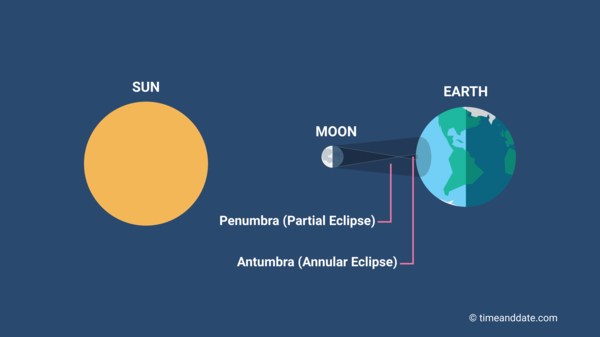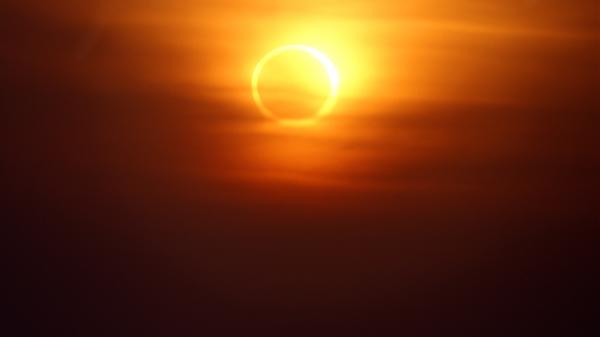Eclipses: What Is the Antumbra?
The antumbra is the lighter part of a shadow that forms at a certain distance from the object casting the shadow. It is involved in annular solar eclipses and planet transits.


The Moon's antumbra.
©timeanddate.com
Like any other opaque objects illuminated by a light source, the Moon and the Earth cast shadows into space as they block the sunlight that hits them. Each shadow has three different areas: the umbra, the penumbra, and the antumbra.
Antumbra Definition
The antumbra is the lighter area of a shadow that appears beyond the umbra, at a certain distance from the object casting the shadow. It only exists if the light source has a larger diameter than the object.
In the antumbra, you will see the outer rim of the light source around the object casting the shadow. For example, if you are in the antumbra during an annular solar eclipse, you can see the edge of the Sun's disk as a “ring of fire” around the Moon.
The other two areas are:
When the Earth enters the Moon's shadow, we see a solar eclipse; when the Moon travels through the Earth's shadow, a lunar eclipse occurs. The type of eclipse depends on the type of shadow that is involved.
Astronomical terms & definitions
Causes Annular Solar Eclipses
The core of the Moon's shadow consists of a dark center that is referred to as the umbra. With growing distance from the Moon, the umbra's diameter decreases, creating a cone-shaped shadow core (see illustration). If the umbra falls on Earth, we can see a total solar eclipse.
As we move further away from the Moon, the umbra is followed by another V-shaped shadow. That is the antumbra. In contrast to the umbra, the antumbra's diameter increases with growing distance from the Moon. Where they meet, the two shadow areas look a bit like an hourglass, if viewed from the side. If the antumbra falls on Earth, we can see an annular solar eclipse.
Antumbra Rarely Falls on Earth
On its journey through space, the Moon always casts a shadow. Most of the time, it includes an antumbra. However, since the antumbra starts at a certain distance from the Moon, beyond the umbra, it does not form if the shadow hits a solid object within the umbra's range. That is the case during a total solar eclipse when the Moon's umbra falls on Earth. This means that somewhere in space, on the dark side of the Moon, an annular solar eclipse is happening right now – unless there is a total solar eclipse in process as you read this.
The reason why annular solar eclipses are so rare is that the Moon's antumbra rarely hits the Earth's surface. Even during an annular solar eclipse, the antumbra only covers a small area on Earth.
As both the Moon and the Earth are in constant motion, the antumbra moves across the face of the Earth during the eclipse, so the annular phase can usually only be seen along a slim eclipse path. For example, the annular solar eclipse on February 26, 2017 was only visible along a narrow belt stretching from southern Latin America to central Africa, and across parts of the South Pacific Ocean and the South Atlantic Ocean.
Why Are Only Some Solar Eclipses Annular?

Annular solar eclipse with “ring of fire.”
©iStockphoto.com/peisen zhao
The spot where the two V-shaped shadows meet and the umbra turns into the antumbra marks the location where the apparent size of the Sun matches that of the Moon. Imagine looking at the Sun from that spot. Sun and Moon appear equally large, so the Moon covers the entire Sun – but only just. If you move closer to the Moon and into its umbra, the Moon's apparent size increases, so the Sun is still completely obscured. If you move away from the Moon and into its antumbra, its size decreases, so the Sun's outer edge becomes visible – the characteristic “ring of fire”.
The Moon's orbit is elliptical, so its distance from Earth changes every day. The difference between its closest and farthest points from Earth (perigee and apogee) amounts to about 50,200 km (31,200 mi).
As it happens, the spot where the umbra meets the antumbra lies within that range. This means that the Moon's umbra falls on Earth when the Moon is close by, so we see a total solar eclipse. Conversely, an annular solar eclipse is visible from Earth if the Moon's distance is greater during the eclipse and the antumbra reaches us.
How Large Is the Moon's Antumbra?
The size of the area on the Earth's surface covered by the Moon's antumbra during an annular solar eclipse depends primarily on the Moon's current distance from Earth. The larger the distance, the larger the antumbra.
If the Moon is at its farthest from Earth (its apogee) during the eclipse, the Moon appears smaller in the sky and the “ring of fire” looks thicker. In that case, the antumbra's path typically reaches a width of just over 100 km (about 60 mi) at the Earth's equator. At higher latitudes, the Sun's rays hit the Earth's surface at a shallower angle, so the antumbra's size grows accordingly.
If the eclipse occurs when the Moon's distance is smaller, only the tip of the Moon's V-shaped antumbra may reach the Earth's surface during parts of the eclipse, meaning that its diameter is close to zero. The annular phase of the solar eclipse then lasts only a short moment. Because of the curvature of the Earth, the eclipse may even begin as an annular solar eclipse when it first hits the Earth's surface and turn into a total solar eclipse in later stages. This rare phenomenon is called a hybrid solar eclipse.
If the Moon is close to its perigee, its closest to Earth, during the eclipse, the Moon's shadow hits the Earth before the antumbra is formed, resulting in a total solar eclipse.
Why Are There No Antumbral Lunar Eclipses?
When the Earth's umbra falls on the Moon's surface, we can see either a total lunar eclipse or a partial lunar eclipse. When the Moon enters the Earth's penumbra, we experience a penumbral lunar eclipse.
So why are there no lunar eclipses involving the Earth's antumbra? And given the fact that the Moon's antumbra falls on Earth during an annular solar eclipse, why does the Earth's antumbra never reach the lunar surface? The reasons are the Earth's size on the one hand and its distance to the Moon on the other.
Earth has a larger diameter than the Moon, which means that its umbral shadow covers a larger distance before the antumbra begins. This means that the distance between the Earth and the Moon is simply too small for the antumbra to form before reaching the Moon – even when the Moon is at its farthest from Earth. In contrast, the Moon is small enough for the antumbra to form before it reaches Earth during annular solar eclipses.
Although the Earth's antumbra never falls on the Moon, it does sometimes reach other planets in our solar system, the distance being much greater. For example, when the Earth lines up with the Sun and Mars, its antumbra falls on the red planet. If you stood on Mars in that moment, you would see Earth as a small dot in front of the Sun.
Planet Transits
During a planet transit of the Sun, Mercury or Venus pass in front of the Sun, as seen from Earth. Because of their large distance from the Earth, their umbras end a long way before they reach the Earth's surface.
This means we travel through a planet's antumbra during a transit. As the antumbra's diameter increases with growing distance, it is very wide when it reaches Earth, so most planet transits take several hours.